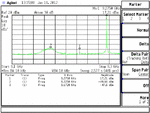ge
Full Member level 5
- Joined
- Jun 23, 2006
- Messages
- 250
- Helped
- 29
- Reputation
- 58
- Reaction score
- 29
- Trophy points
- 1,308
- Location
- Pennsylvania, USA
- Activity points
- 2,772
When changing the Res BW or VBW on a spectrum analyzer, my desired signal level does not change significantly but the amplitude of the spurious (and noise floor) changes. Of course the noise floor changes but why does the spur level change?
tnx
tnx
